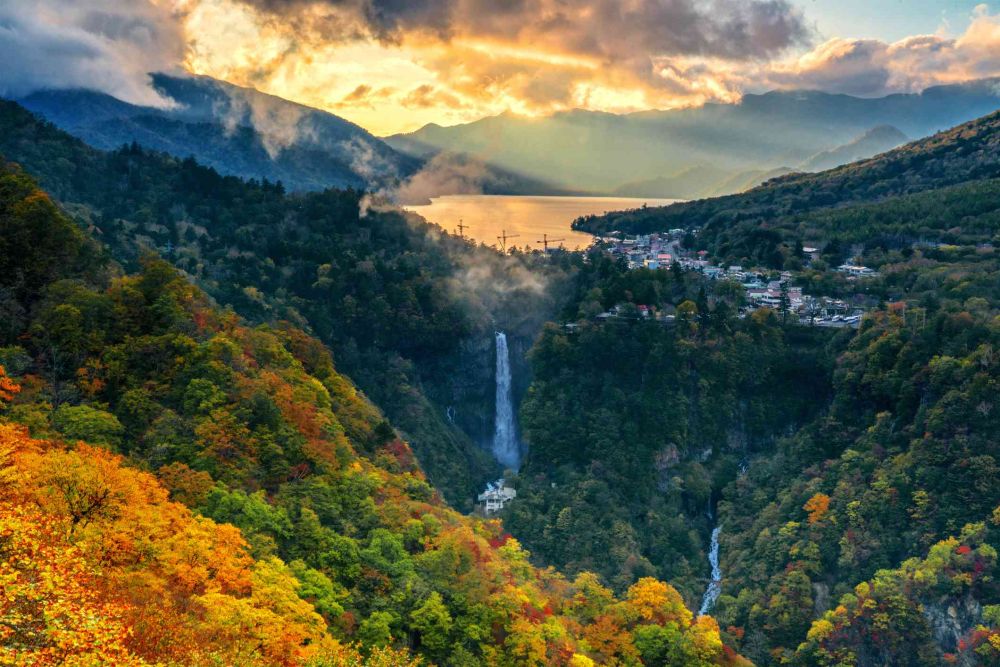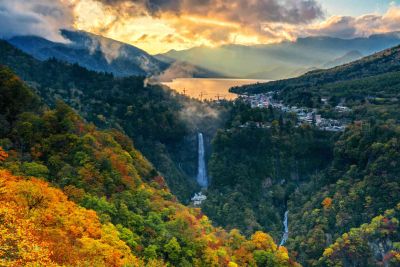

Toshogu Shrine in Nikko is a lavishly adorned shrine complex that serves as the final resting place of Tokugawa Ieyasu, the founder of the Tokugawa shogunate. Recognized as a UNESCO World Heritage Site, the shrine is celebrated for its architectural beauty and historical significance. The intricate carvings, including the famous 'See no evil, speak no evil, hear no evil' monkeys, and stunning gold leaf decorations on the Yomeimon Gate, make it an unforgettable sight. Visitors are often captivated by the blend of Shinto and Buddhist elements, as well as the peaceful surroundings of the evergreen forest. Exploring the many buildings and museum within the shrine grounds offers a deep dive into Japan's feudal era and the shogunate history.
Lake Chuzenji, situated at the foot of Mount Nantai, is one of the scenic highlights of Nikko National Park. A boat tour on this picturesque lake is a peaceful way to enjoy the panoramic views of the surrounding mountains and lush forests. The lake was formed by an eruption of Mount Nantai which blocked the river valley nearly 20,000 years ago. As you glide over the calm waters, you can witness the changing seasons, with cherry blossoms and fresh greenery in spring, vibrant autumn foliage, or a snowy white landscape in winter. The cruises often provide insightful commentary about the history and geography of the area, enriching your experience of this natural wonder.
Senjogahara is a vast marshland field offering a unique hiking environment with an estimated area of 400 hectares. It is situated between Lake Chuzenji and Yumoto Onsen, and represents a beautiful example of Japan's conservation efforts. The area features a well-maintained boardwalk that lets hikers fully immerse in the natural beauty without disturbing the ecosystem. Senjogahara means 'battlefield plateau', a name stemming from a local legend of a battle between gods. The hiking route provides stunning views of nearby mountains such as Mt. Nantai, allowing hikers to witness vegetation transitions from marsh to forest. The trail is also renowned for its birdwatching opportunities, as it is home to various species of birds, including rare ones, which visitors might spot along the way.
Yumoto Onsen is a hot spring resort area situated at a high altitude in the northern reaches of Nikko National Park. It is renowned for its acidic sulfuric waters believed to have healing properties for various ailments. The area has been a popular bathing spot since ancient times, surrounded by serene landscapes and featuring several ryokan (traditional Japanese inns) where visitors can enjoy a relaxing soak in the onsen baths. Some ryokan offer day-use access to their baths for those not staying overnight. The picturesque setting among the mountains, combined with the therapeutic effects of the hot springs, makes Yumoto Onsen an ideal spot to unwind after a day of exploring Nikko's natural beauty.
Kanmangafuchi Abyss is an impressive gorge formed by an eruption of Mount Nantai along the Daiya River. This natural marvel is located just a short walk from Nikko's town center and is known for its row of Jizo statues, which are meant to protect children and travelers. The statues, with their red bibs, create a poignant and slightly mysterious atmosphere as they stand among the greenery, overlooking the rushing waters. The gorge offers a scenic and peaceful riverside walk, where visitors can enjoy the sound of the river, the lush surroundings, and occasional spots of rap able from the valley above as they traverse this geological wonder. Kanmangafuchi is not only a testament to the power of nature but also a place of spiritual significance and contemplation.
Nikko Edomura, also known as Edo Wonderland, is a cultural theme park that transports visitors back to the Edo period of Japan, providing an immersive experience in a recreated historical setting. With actors in traditional costumes, visitors can wander through a village with authentic architecture, enjoy period-appropriate entertainment such as ninja shows and samurai swordfight demonstrations, and participate in various interactive experiences. Guests can also dress up in Edo-period costumes to fully immerse themselves in the past. The park offers an entertaining and educational glimpse into the lifestyle and culture of Japan during the 17th-19th centuries, making it a fun-filled learning adventure for visitors of all ages.
Cycling is a fantastic way to enjoy the vast landscapes of Nikko National Park at your own pace. With various rental shops offering bicycles for visitors, you can embark on a ride through different scenic routes, including lake circuits or more challenging mountain paths. Cycling around the park allows you to appreciate the natural beauty up close, stop at your leisure to take photos or have a picnic, and visit the park's cultural landmarks such as Toshogu Shrine or Rinnoji Temple. Whether you choose an electric-assist bicycle for a more leisurely journey or a mountain bike to tackle rugged terrain, cycling in Nikko offers a refreshing way to explore this historically and naturally rich area.
Ryuzu Waterfall, translating to 'Dragon Head Waterfall', is one of Nikko's most famous natural sights. It is located near Lake Chuzenji and is particularly spectacular during autumn when the surrounding trees paint a vibrant backdrop of red and gold. The waterfall is characterized by its bifurcated flow, resembling a dragon's head, which cascades down over a rocky outcrop into a serene pool below. Just a short walk from the parking area, visitors can reach a viewing platform that provides an excellent vantage point for photography or simply enjoying the sights and sounds of the waterfall. A nearby restaurant also offers picturesque views of Ryuzu Waterfall, allowing guests to enjoy local cuisine with a stunning view.
Kegon Falls is considered one of Japan's three most beautiful waterfalls, with water dropping a stunning 97 meters into a gorge below. It is the most famous of Nikko's many beautiful waterfalls and serves as the outlet for Lake Chuzenji. Visitors can take in the grandeur of the falls from a free observation platform at the top or pay to take an elevator down to a lower observation deck for a closer view and the full impact of the thundering water. In the colder months, the falls are particularly breathtaking as icicles form around the cascade, creating a winter wonderland. The beauty of the falls is enhanced by the lush greenery in the spring and summer and vibrant autumn leaves, making it a must-visit destination year-round.
Winter transforms Nikko into a snowy paradise, and one of the most exciting ways to explore this landscape is by snowshoeing. In the Oku-Nikko area, visitors can strap on snowshoes and trek across the pristine, snow-covered grounds of the park. Guided tours often take you through silent forests, across frozen lakes, and offer the chance to see wildlife tracks or even catch a glimpse of the animals themselves. This activity provides a magical perspective of the park's beauty, away from the usual tourist tracks, and deep into the ethereal winter scenery of Nikko. Snowshoeing is suitable for all levels, from beginners to experienced hikers, and it's a unique way to experience the peace and tranquility of the snow-blanketed landscape.
